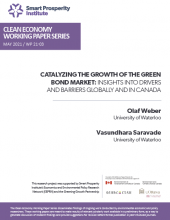By Olaf Weber and Vasundhara Saravade
As the face of sustainable finance around the world, the green bond market provides a perfect opportunity to examine how the financial sector is reacting to the opportunities and risks posed by climate change and the low-carbon economy. Given the role of financial institutions in driving capital towards the economy, it is integral to understand what motivates them to participate in this evolving sustainable finance market. In order to meet the challenge for financing the transition, Canadian organizations not only need some guidance to align their investment and issuance priorities, but also help other smaller organizations overcome any existing barriers.
Based on findings from market interviews and an online survey, this policy report helps address the knowledge gaps on what can be done to scale-up the green bond market and sustainable finance, especially in Canada. Our research shows that green bonds are able to successfully mainstream the concept of sustainable finance by helping investors and issuers label their financial products or investments as green. Not only do they prescribe the use of post-issuance reporting to track environmental impacts of investments, but they also encourage more educational awareness around climate impacts and its risk to the financial sector. However, due to the evolutionary nature of sustainable finance, challenges like greenwashing or additionality measurement are currently affecting this market. In Canada, the need to tap into this market’s potential is amplified by the nature of the economy and its exposure to climate risks.
Recommendations to address these barriers and help scale up the market in Canada include: showing global leadership in terms of aligning resource-based sectors towards the low-carbon transition; documenting additionality by setting trackable climate targets and benchmarks towards this transition; looking more at adaptation projects and nature-based solutions when issuing green bonds; creating more meaningful performance indicators by using scientifically-backed measurement tools; and finally, helping provide liquidity to the market by issuing sovereign green bonds and other forms of government involvement, guaranteeing that green bonds are a means to achieve the transition to a low-carbon economy.
- Read the working paper Catalyzing the Growth of the Green Bond Market Insights into Drivers and Barriers Globally and in Canada
- Read the newly published paper: Catalyzing the growth of green bonds: a closer look at the drivers and barriers of the Canadian green bond market
The Clean Economy Working Paper Series disseminates findings of ongoing environmental and clean economy work conducted by researchers from a range of disciplines. These working papers are meant to make results of relevant scholarly work available in a preliminary form. Although these papers have not undergone a peer-review process, they meet general standards of scholarly excellence. The views expressed in these working papers are those of the authors and do not necessarily reflect the opinions of Smart Prosperity Institute.




